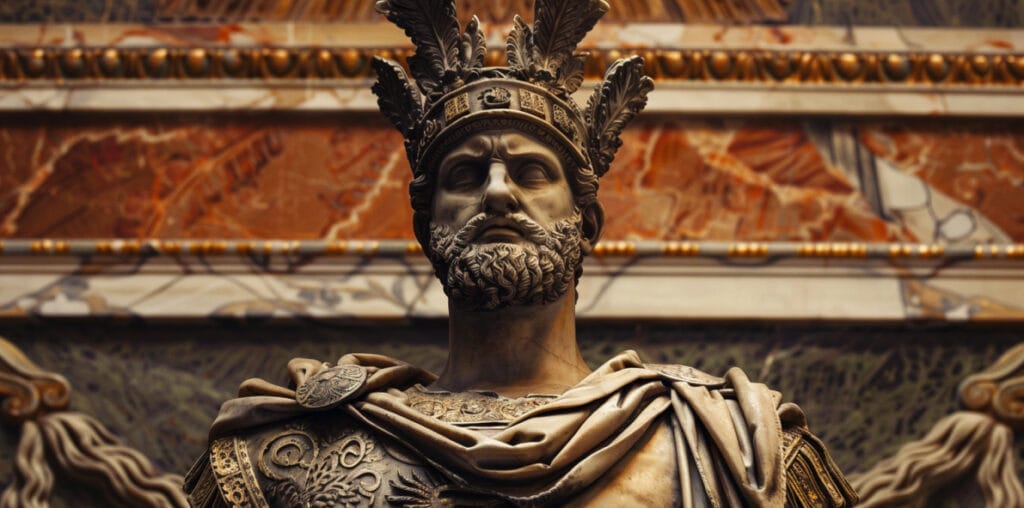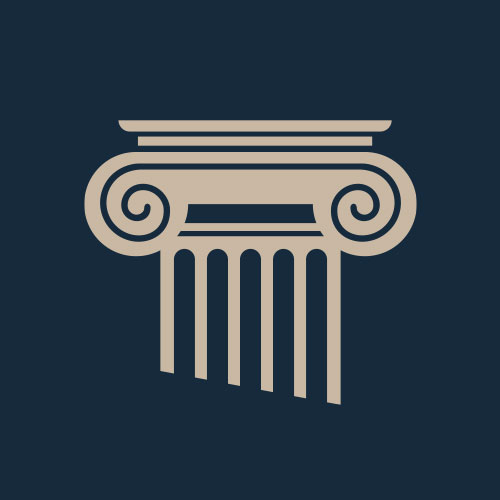Life: AD c. 250 – 311

- Name: Gaius Galerius Valerius Maximianus
- Born AD ca. 250 at Florentiniana, Upper Moesia.
- Became emperor on 1 May AD 305.
- Wife: (1) Galeria Valeria (one daughter; Valeria Maximilla), (2) an unknown concubine (one son; Candidianus).
- Died at Nicomedia, May AD 311.
Early Life
Galerius was born in about AD 250 in a little Danubian village near Florentiana in Upper Moesia. His father was a simple peasant, and his mother, called Romula, came from beyond the Danube. At first, it appears he worked as a herdsman before joining the army. Once in the army, though, he enjoyed a successful career, rising to be a senior officer during the reign of Diocletian.
Becoming a Caesar (Junior Emperor)
In AD 293, at the establishment of the tetrarchy, Galerius, together with Constantius Chlorus, was chosen from the senior military leaders to be Caesar (junior emperor). Of the two, he was to rank as the junior Caesar. It was at this point he assumed the name Gaius Valerius Maximianus. Being the eastern Caesar, he fell under the authority of Diocletian and was entrusted with rule of the powerful Balkan provinces in the Dioceses of Pannonia, Moesia, and Thraciae and the Diocese of Asiana in Asia Minor (Turkey).
Naturally, this meant his most important task was to guard the Danube frontier against the Goths. And so for the years AD 294 and 295, he busied himself by repelling any incursions by Goths, who were increasing their pressure on the frontiers again. Then, in AD 296 and 297, he was to be doing the same again to the Sarmatians and Marcomanni. In a more eccentric move of Galerius’, the northern half of the province of Lower Pannonia was divided off and formed into an altogether new province called Valeria, the name of his wife.

War Against Persians
In AD 296, Diocletian called his Caesar to the east to help deal with the Persians. Diocletian being occupied with the rebellion of Lucius Domitius Domitianus and his successor Aurelius Achilleus in Egypt, the Persian king Narses had seized the opportunity to invade Syria. Galerius crossed the river Euphrates but appears to have clearly underestimated his Persian foe. And so he suffered a severe defeat and needed to withdraw, in doing so, losing the province of Mesopotamia to the enemy.
He crossed the river Euphrates but appears to have clearly underestimated his Persian foe. And so he suffered a severe defeat and needed to withdraw, in doing so, losing the province of Mesopotamia to the enemy. It is traditionally said that Diocletian punished him for his failure in an act of dire public humiliation by forcing him to walk a mile in front of his chariot while dressed in his imperial robes. However, it is very doubtful that this ever really took place.
Defeating King Narses
In AD 297, Galerius though made a second attempt at defeating the Persians. This time, well prepared with a strong army, he marched into Armenia and crushed the Persian force, capturing an enormous amount of booty and even the harem of King Narses. Moving into Mesopotamia, his’ advance had the Persian defense collapsing before him, and he conquered the Persian capital, Ctesiphon.

Badly mauled, the Persians sued for peace. In AD 298, the province of Mesopotamia, together with even some territory from across the river Tigris, was restored to Rome. The treaty with the Persians most likely had more to do with Diocletian than Galerius. Galerius, hungry for glory and eager to erase the memory of his earlier defeat, was known to have wanted to press on.
Persecution of the Christians
The decisive defeat of the Persians raised Galerius’ standing immensely. It is believed that his influence with Diocletian grew. To the extent that there is even some suggestion that the harsh persecution of the Christians by Diocletian might actually have been due to his influence.
Much points toward Galerius in this respect, and his mother, Romula, was said to have been a fanatical paganist. Having grown up under the influence of such religious zealotry, it is well possible that his feelings should have been very hostile toward other religions. The fourth and harshest edict of Diocletian against the Christians (AD 304) is widely believed to have been entirely the work of Galerius.

Becoming an Augusti
In AD 305, Diocletian and Maximian abdicated. The Caesars Galerius and Constantius, thereby, became Augusti and Severus II, and Maximinus II Daia acceded to the vacant positions of Caesar. He was theoretically the junior of the two Augusti, but he didn’t show the respect Maximian had awarded Diocletian’s seniority. In fact, he controlled the greater territory of the empire, and he could count on the loyal support of both of the two Caesars.
Furthermore, Constantius’ son Constantine was a guest at his court and so acted as a virtual hostage to ensure Galerius’ supremacy. Sure enough of his position, he eventually agreed to return Constantine back to Constantius when his colleague embarked to Britain to repel incursions by the Picts. Constantius died during this stay in Britain, leaving him as the undisputed senior Augustus. He raised Severus II to the rank of co-Augusus to fill Constantius’ position in the west and elevated Constantine to Caesar.
The Era of Two Emperors
However, Maxentius, the son of Maximian, was not prepared to accept his expectations of an imperial position to be ignored any longer. And so he revolted in Rome, declared himself Augustus, and recalled his father Maximian to rule with him as joint emperor.
First Severus II, then Galerius tried to oust the usurpers from Italy, but without success. Plagued by desertions among their troops and faced with the authority of an emperor previously Galerius’ senior, Severus II lost his life, and Galerius suffered a severe blow to his authority. His reputation was damaged, but he still was able to exert influence over the Conference of Carnuntum. And so it was Galerius’ choice, Licinius, who was appointed Augustus in place of Severus II (AD 308).

Galerius’ Health Problems
In AD 311, preparing for his twentieth-anniversary celebration as Caesar and Augustus, Galerius was believed by some to be planning to abdicate, with the intention of raising his illegitimate son Candidianus to the rank of Caesar. However, he was suddenly overcome by a serious disease.
First, his genitals suffered a severe inflammation, followed by the growth of a deep ulcer, which was soon befallen by worms and began to swell and rot on his body. Some of Galerius’ doctors were simply unable to endure the stench. These were executed immediately. The other doctors fared no better, for they too were killed for not having been able to cure their emperor’s disease.
Changing his Position on Christians
From his sick-bed at Nicomedia on 30 April AD 311, Galerius issued an edict, which was confirmed by his fellow emperors, canceling the persecution of the Christians. Much has been made of this change of mind by Galerius. Religious leaders have scribed his horrendous illness to the wrath of god. Others believe that the illness combined with Galerius’ guilty conscience might have led him to doubt if he was suffering some form of divine retribution. Again, other theories point toward Licinius or Constantine for having been the true initiators of the edict, Galerius only having confirmed it.

It is very likely that Galerius did, in the end, conclude that his policy of persecution had failed. Rather than suppress the Christian faith, their fate had won them sympathy throughout the empire. After only a few days following the signing of the decree to stop Christian persecution, Galerius succumbed to his gruesome illness (May AD 311).
People Also Ask:
Who is emperor Galerius?
Galerius (born near Serdica, Thrace [now Sofia, Bulg.] —died 311) was a Roman emperor from 305 to 311, notorious for his persecution of Christians. He was born of humble parentage and had a distinguished military career.
Who defeated Galerius?
Narseh then moved south into Roman Mesopotamia, where he inflicted a severe defeat on Galerius, then commander of the eastern forces, in the region between Carrhae (Harran, Turkey) and Callinicum (Raqqa, Syria).
What was the disease that the emperor Galerius had?
After the careful investigation of the ancient sources and the exhaustive specialist consensus attempts, we can reasonably surmise that Emperor Galerius died of Fournier gangrene.
How long did Galerius rule?
Gaius Galerius Valerius Maximianus was a Roman emperor from 305 to 311. During his reign, he campaigned, aided by Diocletian, against the Sasanian Empire, sacking their capital Ctesiphon in 299.
Why did Galerius end persecution?
Galerius grew disheartened when he saw that his efforts had failed to stamp out the Christian religion. Dying for cancer that was literally rotting his body, he suspended the persecution in 311. He then pleaded for Christians to pray for his health.
Which Roman emperor killed the most Christians?
The persecutions culminated with Diocletian and Galerius at the end of the third and beginning of the 4th century. Their anti-Christian actions, considered the largest, were to be the last major Roman pagan action.

Historian Franco Cavazzi dedicated hundreds of hours of his life to creating this website, roman-empire.net as a trove of educational material on this fascinating period of history. His work has been cited in a number of textbooks on the Roman Empire and mentioned on numerous publications such as the New York Times, PBS, The Guardian, and many more.
